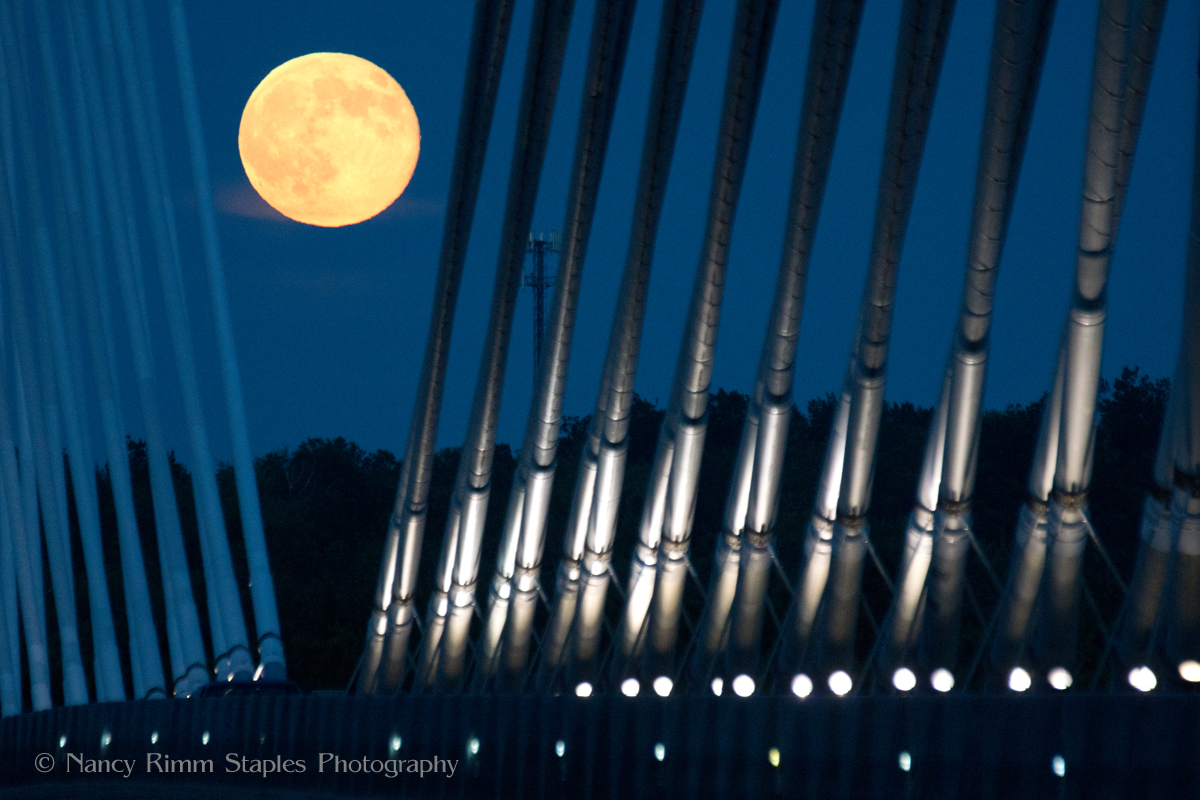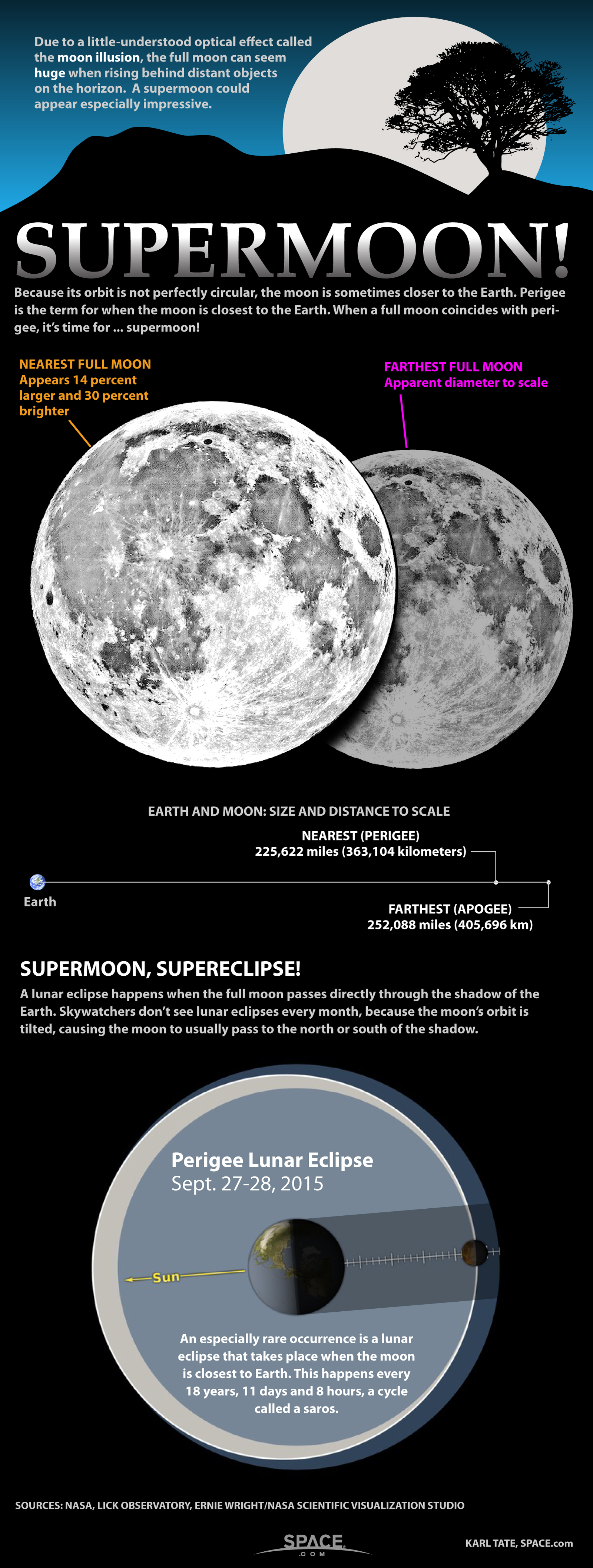
No doubt by now you've likely heard about the excitement concerning what supposedly will loom large in our sky on Sunday night. It's the "Super Moon!"
Well ... maybe not quite.
I really don't want to be the wet blanket at your moon party, but while Sunday’s full moon will indeed be big and close – to be sure, it's the biggest and closest full moon of 2014 — it actually falls just short of being bestowed the title of a "super" moon. [The Moon: 10 Surprising Facts]
First, where did the term "supermoon" come from? Interestingly, it originated not from astronomy, but modern astrology. It was first used by astrologer Richard Nolle in 1979, who arbitrarily defined it as … a new or full moon which occurs with the moon at or near (within 90 percent of) its closest approach to Earth in a given orbit (which scientists call "perigee").
Still, nobody paid much attention to Nolle's definition until the full moon of March of 2011, when the moon arrived at an exceptionally close perigee distance that brought it within 126 miles (202 kilometers) of its closest possible approach to Earth.

Secrets of the supermoon
Suddenly, the term "supermoon" went viral. Now, it seems that every time a full moon coincides with perigee, it is referred to as a supermoon.
Once a year the moon turns full within a few hours of perigee. After this Sunday, the next time this will happen will be on Sept. 28, 2015. But really, shouldn't we reserve such an honorific title only for those full moons that come exceptionally close to Earth (as in 2011)?
Get the Space.com Newsletter
Breaking space news, the latest updates on rocket launches, skywatching events and more!
And now we are "watering down" the supermoon definition even more ... last month's full moon on July 13 as well as next month's full moon on Sept. 8 are also being branded as supermoons, seemingly because they fall within 90 percent of moon's closest approach to Earth, or to put it in other words, within the top 10 percent of the closest full moons. Even some NASA websites now endorse this definition. So now in most years we have not just one but three supermoons.
But just how "super" is that?
As Dr. Neil deGrasse Tyson, Director of New York's Hayden Planetarium jokingly noted recently in a tweet: "The perennially hyped name 'Super Moon' insults the legacy of Superman, Super Volcanoes, Supernovae, and even Super Mario."
So what should be the proper definition for a "super" moon? I have a suggestion which I'll get to later.
But first, be advised that Sunday's full moon will occur at 2:09 p.m. EDT (1809 GMT), so Americans will not get to see the exact moment that the moon is full; when it comes above your local horizon on Sunday evening technically you’ll be looking not at a "full" moon, but a waning gibbous moon.
Also, it's time to correct a couple of points that are being bandied about by the mainstream media:
Point 1: "The supermoon will appear 14 percent larger than normal."
This statement is false.
Assuming that "normal" refers to the moon’s mean distance from the Earth of 238,855 miles (384,400 km), Sunday's supermoon actually will appear 7.2 percent larger than normal, not 14 percent! [Supermoon Secrets: 7 Big Moon Facts]
Most media outlets get it wrong in that the "14 percent" really refers to the difference between the moon's closest point to Earth (perigee) versus its farthest point (apogee). The absolute closest that the moon can come to Earth is 221,439 miles (356,372 km), and the absolute farthest distance is 252,724 miles (406,720 km).
But wait a minute, that's a difference amounting to 12.4 percent.
So just where did that spurious 14 percent value come from? I believe I've located the source:
In the October 1989 issue of Sky & Telescope, on page 405, we read in the Moonwatcher's Corner column: "Tidal force varies as the inverse cube of an object's distance. This month the Moon is 14 percent closer at perigee than apogee."
That incorrect value of 14 percent has apparently proliferated ever since.
Point 2: "The supermoon will appear 30 percent brighter than normal."
Again, another incorrect statement.
While the full moon's distance from Earth is one factor in determining its brightness, an even more important factor is the sun itself. When the Earth is near perihelion (closest point to the sun) the moon receives more sunlight than under average circumstances. Conversely, when the Earth is near aphelion (farthest point from the sun) the moon receives less sunlight than average. [The Full Moon: Why It Happens (Video)]
In 2014, aphelion occurred 37 days prior to Sunday's supermoon.
The moon's perigee distance from Earth on Sunday will be 221,765 miles. Let's suppose that a person sees the moon directly overhead, yielding a distance from the Earth’s surface to the moon’s center of only 217,806 miles. The Earth's distance from the sun at that same time was 1.014 astronomical units (1 astronomical unit, or 1 AU, is the Earth's mean distance from the sun — about 93 million miles or 150 million km).
Now, remembering that the mean ("average") distance of the Earth-moon is 238,855 miles and the Earth-sun 1 AU, and that the apparent brightness of a body varies inversely as the square of its distance, we find that Sunday's full moon is (238,855/217,806)2 x (1.0/1.014)2 = 1.169 or 16.9 times as bright as a "normal" full moon, not 30.
More likely the media again got their semantics wrong … they likely meant to say that the "supermoon" is 30 percent brighter than when the moon is at apogee (its farthest point from the Earth).
The next full moon that coincides with apogee will be on March 5, 2015. So how much brighter will Sunday's full moon compared to next March?
I did the calculation and found that it's indeed 30 percent brighter (30.7 to be more precise).
But that also corresponds to a small increase of just 0.28 of a magnitude (the brightness measurement used by astronomers), so the moonlight on Sunday night will not be exceptionally bright.

Unrealistic expectations
There are always many images published on the Internet in advance of a "supermoon," depicting exceedingly large full moons taken with telephoto lenses, all implying that the moon was going to look amazingly large in the sky (perhaps some were even thinking of the abnormally large moon in the 2003 Jim Carrey movie "Bruce Almighty").
But unless you catch the moon when it's either rising or setting — and appearing briefly larger than normal because of the famous "moon illusion" — this weekend's August full moon will look pretty much like any other full moon.
And yes, there are those who think that they will be seeing an exceptionally dazzling full moon come Sunday night. Last year, a friend of mine told me that she was expecting the 2013 version of the "supermoon" to look "radically brighter," "Like with those 3-way light bulbs; I thought it was going to be like turning the moonlight up a notch."
But so far as full moons are concerned, an increase of 0.28 magnitude is hardly perceptible to the eye if at all.
Redefining the term "supermoon"
As I noted earlier, I'm of the opinion that the "supermoon" title shouldn't be used so often. Indeed, for the moon to be truly a "super" moon, I would think it needs to come exceptionally close, as it did in back in March 2011.
So why not define it as coming to within 99 percent of its closest possible approach (as opposed to the current definition of 90 percent?)
That would place it within the one-percent range of 221,439 to 221,752 miles.
Using this criterion, Sunday's supermoon will fall just short of making the "super cut," by just 13 miles (21 km). And next year, on Sept. 27, the full moon comes even closer, missing supermoon status by just a scant 1 mile (1.6 km)!
Maybe we can call these two cases "almost supermoons."
In fact, the next truly "super" moon (since 2011) will not come until Nov. 14, 2016, when it will be only 221,524 miles away (356,508 km), placing it within a mere 85 miles (136 km) of its closest possible approach! That full moon will also be the closest of this decade.
So here is my list on the supermoons of this decade using my own "Rao 1-percent Rule":
Date: March 19, 2011
Moon-Earth Distance: 221,565 miles (356,575 km)
Date: Nov. 14, 2016
Moon-Earth Distance: 221,524 miles (356,506 km)
Date: Jan. 1, 2018
Moon-Earth Distance: 221,559 miles (356,565 km)
Visually, you probably won't notice anything unusual about that moon either, but if you you're looking for a full moon that's truly going to be exceptionally close, mark your calendars.
You can see the August supermoon online on Sunday courtesy of a free webcast by the Slooh Community Observatory, which offers live night sky views via remotely operated telescopes. The webcast begins at 7:30 p.m. EDT (2330 GMT). It will also be carried live on Space.com, courtesy of Slooh.
Editor's note: If you snap an amazing photo of the August full moon and would like to share it for a potential story or gallery, you can send images and comments to managing editor Tariq Malik at: spacephotos@space.com.
Joe Rao serves as an instructor and guest lecturer at New York's Hayden Planetarium. He writes about astronomy for Natural History magazine, the Farmer's Almanac and other publications, and he is also an on-camera meteorologist for News 12 Westchester, N.Y. Follow us @Spacedotcom, Facebook or Google+. Originally published on Space.com.
Join our Space Forums to keep talking space on the latest missions, night sky and more! And if you have a news tip, correction or comment, let us know at: community@space.com.

Joe Rao is Space.com's skywatching columnist, as well as a veteran meteorologist and eclipse chaser who also serves as an instructor and guest lecturer at New York's Hayden Planetarium. He writes about astronomy for Natural History magazine, Sky & Telescope and other publications. Joe is an 8-time Emmy-nominated meteorologist who served the Putnam Valley region of New York for over 21 years. You can find him on Twitter and YouTube tracking lunar and solar eclipses, meteor showers and more. To find out Joe's latest project, visit him on Twitter.










